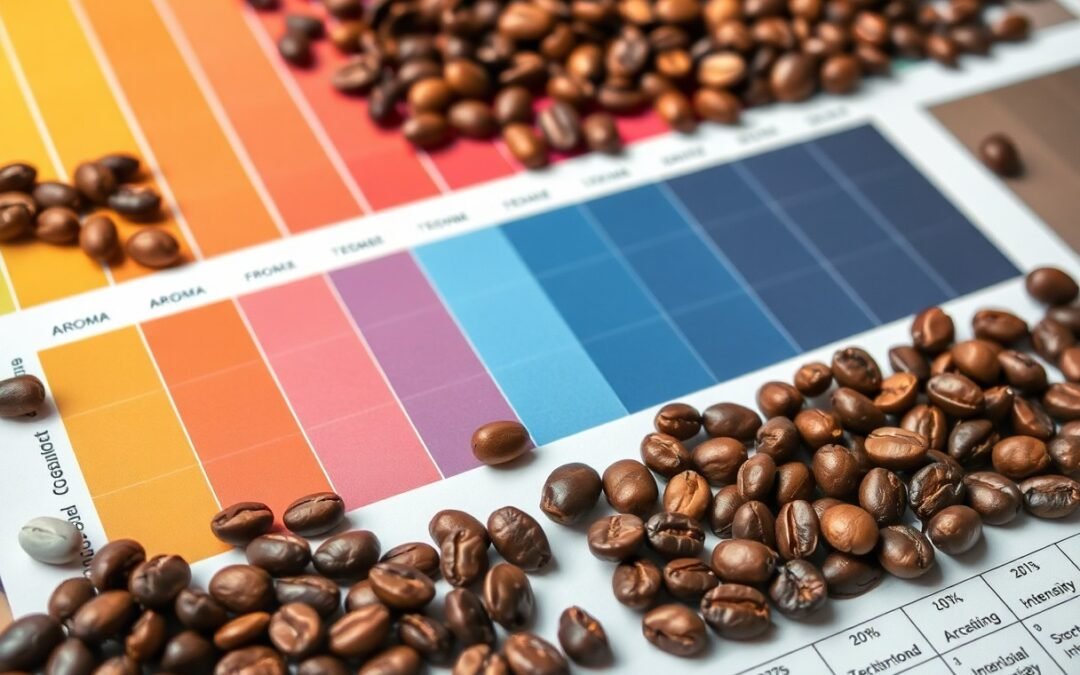With the growing interest in coffee, you may wonder how roasting gradients impact the aroma of your brew. This post explores whether varying the roasting process affects not just the intensity of aromas but also their timbre and complexity. Understanding these nuances can elevate your coffee experience, enabling you to make informed choices about roasting techniques and their sensory outcomes.
The Chemistry of Aromatic Compounds
Aromatic compounds play a pivotal role in defining the aroma profile of roasted coffee. These volatile molecules are generated during roasting through complex chemical reactions such as Maillard reactions and caramelization. Diverse compounds like esters, phenols, and ketones contribute to the unique aromatic attributes you experience in your cup, influencing both the intensity and complexity of flavors. Understanding these compounds provides insight into how your chosen roast intensity can affect the aromatic experience of coffee.
Key Molecules Contributing to Aroma Intensity
The Role of Heat in Flavor Development

Decoding Roasting Gradients
Roasting gradients play a pivotal role in how you perceive aromas in coffee. The varying degrees of heat applied during the roasting process not only alter the flavor profile but also the intensity and complexity of the aromas. Understanding these gradients enables you to select coffees that align with your taste preferences. From fruity and floral notes in lighter roasts to deep, rich char in darker varieties, you can fine-tune your brewing experience by grasping the nuances of these roasting techniques.
Light vs. Dark Roasts: A Comparative Analysis
| Aroma Intensity | Light roasts emphasize brightness and fruitiness, while dark roasts provide deeper, bolder notes. |
| Flavor Diversity | Light roasts showcase intricate flavors; dark roasts present more uniform tastes due to caramelization. |
| Acidity Levels | Higher in light roasts, providing crispness; dark roasts tend to be smoother with lower acidity. |
| Aftertaste | Light roasts leave a clean finish; dark roasts often end with a lingering bitterness. |
The Impact of Temperature and Time on Aroma
| Temperature Increase | Brings out caramel and chocolate notes, enhancing depth but risking burnt aromas if excessive. |
| Prolonged Roasting | Can lead to loss of nuanced flavors, resulting in a more homogeneous aroma profile. |
| Optimal Roasting Duration | A balance ensures aromatic compounds develop while avoiding undesirable flavors. |
Temperature and time are key to achieving the desired aroma in coffee. Excessive heat can transform delicate floral and fruity notes into undesirable burnt characteristics. For instance, a light roast held too long at high temperatures may lose its vibrancy, while a well-timed dark roast can enhance chocolate and caramel notes without sacrificing depth. Monitoring these factors empowers you to manipulate aroma profiles effectively, catering to your specific taste preferences.
| First Crack Timing | Indicates starting point for light roasts, crucial for necessary aromatic compound release. |
| Rate of Cooling | Quick cooling post-roasting locks in desirable aromas, whereas slow cooling may alter them. |
| Maillard Reaction | Crucial for the development of rich flavors and aromas, occurring at moderate temperature increases. |

The Sensory Perception of Coffee
Your experience of coffee isn’t just about taste; aroma plays a pivotal role in how you perceive its overall quality. Scientific studies reveal that nearly 80% of flavor is derived from aroma, with complex chemical compounds interacting with your olfactory senses. Each roast level produces distinct aromatic profiles, ranging from fruity and floral notes in lighter roasts to rich, deeper scents in darker varieties. Understanding these sensory perceptions can enhance your appreciation and enjoyment of coffee.
How We Experience Aroma: The Human Factor
Your ability to discern and appreciate coffee aromas is influenced by both individual and environmental factors. Genetics can affect your sensitivity to certain scents, while past experiences shape your preferences. Cultural background also plays a role, as different regions may be more attuned to specific aromas based on local coffee varieties and roasting traditions. Consequently, your unique combination of sensory perception and personal history informs how you engage with coffee’s aromatic complexity.
Timbre vs. Intensity: Distinguishing the Nuances
Timbre and intensity refer to different aspects of aroma in coffee. While intensity speaks to the strength or concentration of aroma, timbre involves the quality and character of that aroma. For instance, a coffee might have a high-intensity aroma but low timbre if the scent lacks complexity. Conversely, low intensity might still present a rich, diverse aroma profile. This distinction plays a significant role in how you evaluate and enjoy coffee, as a harmonious balance between timbre and intensity enhances the overall tasting experience.
To further clarify the distinction between timbre and intensity, consider how a coffee with a strong aroma of chocolate can have a rich timbre even at lower intensity levels, suggesting complexity and depth. In contrast, a highly intense smell of burnt sugar might overpower other notes but lack intricate characteristics, making it less enjoyable. Quality coffee often achieves a blend of both, where layered aromas unfold as you sip. This interplay can elevate your coffee-drinking experience, making it more rewarding and nuanced.
Practical Implications for Roasters
Understanding how roasting gradients affect aroma’s intensity and timbre allows you to make informed decisions in your roasting process. By adapting your techniques, you can enhance specific flavor notes depending on your target audience. For example, lighter roasts can highlight fruity and floral aromas, while darker roasts may emphasize chocolate and caramel notes. This knowledge not only improves consistency but also increases customer satisfaction by delivering a product that aligns with consumer preferences.
Tailoring Roasting Profiles to Desired Flavor Profiles
Customizing roasting profiles to achieve specific flavor attributes enables you to cater to diverse consumer palates effectively. By adjusting variables such as temperature and duration, you can fine-tune the balance between acidity, sweetness, and body. For instance, if you aim for a bright and fruity cup, a shorter roast time at a lower temperature might be your best strategy, while for deeper, earthy tones, a longer period at a higher temperature could be beneficial.
Experimentation and Innovation in Roasting Techniques
Embracing creativity in roasting can lead to unique flavor discoveries and profiles. You can experiment with different batch sizes, airflow adjustments, and even varying the type of beans used in tandem with roasting gradients. Techniques like profile roasting, where you change temperature over time during the roast, can unveil complex flavor layers that engage your customers’ senses. Listening to feedback allows you to refine these innovations continuously.
Innovation in roasting doesn’t stop at simple techniques; it also encompasses the exploration of novel methodologies and equipment. For instance, you could try using a sample roaster to test various profiles before committing to production, which reduces waste while allowing for precise control over the outcome. Integrating technology, such as data analytics, can also help you track how slight adjustments influence flavor and aroma. Engaging in this iterative process fosters a deeper understanding of how roasting dynamics interact with bean characteristics, yielding exceptional and distinctive coffee profiles.
Expanding the Aroma Conversation
Discussions about coffee aroma can open pathways to a deeper understanding of this beloved beverage. Engaging with diverse viewpoints encourages a more rounded appreciation of not just aroma, but overall coffee experience. Exploring cultural perspectives, seasonal variations, and personal anecdotes can enrich your relationship with coffee, allowing you to recognize the infinite nuances that influence its aroma while expanding your sensory horizons.
Broader Impacts Beyond Aroma: Taste and Texture
The interplay of aroma with taste and texture significantly enhances your coffee experience. Aroma and flavor are interdependent; for instance, the presence of certain aromatic compounds can heighten sweetness or acidity, shaping your overall perception. Similarly, how the coffee feels in your mouth—its body and mouthfeel—interacts with its aromas, creating a multifaceted profile that can elevate your enjoyment and appreciation.
The Evolving Landscape of Coffee Appreciation
Your journey in coffee appreciation is constantly evolving, influenced by trends, innovations, and increased accessibility to specialty coffees. As you explore various brewing methods, regional varieties, and processing techniques, each aspect reshapes your understanding of flavor and aroma. Educational resources, cupping sessions, and community events further enhance your knowledge, enabling you to articulate your preferences and engage more deeply with what’s in your cup.
In recent years, the rise of the specialty coffee movement has transformed how you experience coffee. As direct trade practices become more prevalent, there’s a greater emphasis on transparency regarding sourcing and production. Increased access to diverse beans from different origins allows you to explore unique flavor profiles. Workshops and tastings enhance your ability to discern flavor nuances, cultivating a discerning palate. This ongoing evolution encourages a culture of continuous learning, inviting you to appreciate not only the coffee itself but also the careful craftsmanship behind it.
To wrap up
Upon reflecting, you can conclude that roasting gradients significantly influence not just the intensity but also the timbre of aromas in your coffee. As you experiment with different roast levels, you will notice how lighter roasts yield brighter, more floral notes, while darker roasts bring forth deeper, richer characteristics. Understanding this relationship allows you to tailor your roasting techniques, enhancing your sensory experience and enabling a more precise control over the flavor profile you desire in your brew.
FAQ
Q: Do roasting gradients affect the aroma intensity of coffee?
A: Yes, roasting gradients can influence aroma intensity. As beans roast longer at higher temperatures, more volatile compounds are produced, which can heighten the overall aroma experience.
Q: What is the difference between aroma intensity and aroma timbre?
A: Aroma intensity refers to the strength or potency of a smell, while aroma timbre describes the distinct characteristics and complexity of the fragrance resulting from different roasting levels.
Q: At what roasting stage do aroma notes typically change?
A: Aroma notes typically change during the Maillard reaction and caramelization stages, which occur between light and medium roasts. As temperatures rise, certain flavor compounds evolve, altering the profile.
Q: Can lighter roasts have more complex aromas compared to darker roasts?
A: Yes, lighter roasts often preserve more of the bean’s original characteristics and complex flavors, leading to a wider range of aroma notes. Darker roasts tend to emphasize deeper, more uniform aromas.
Q: How do roasting gradients impact specific aroma notes like fruity or nutty?
A: Roasting gradients can enhance or diminish specific aroma notes. Fruity notes are more pronounced in lighter roasts, while nutty or chocolatey notes typically become more dominant in darker roasts due to the breakdown of acids and sugars.

